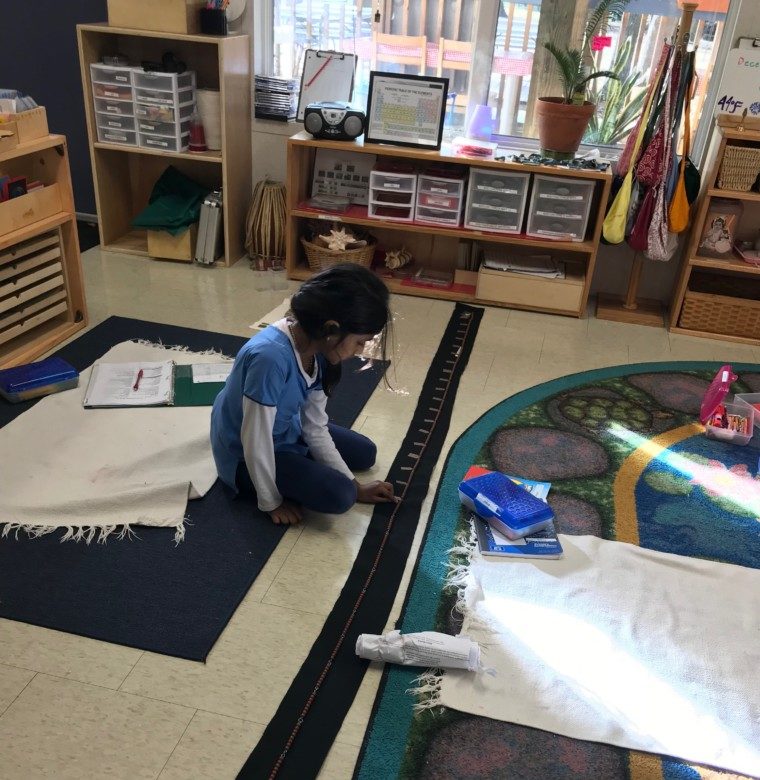
Alachua, Fla. – The art projects were distinct from most others. Students at Bhaktivedanta Academy had to use pieces of trash to create artwork weighing less than 50 pounds.
The project, Trashformations, was part of the 19th-annual student recycled art competition sponsored by the Alachua County Commission.
Students at the academy, which is rooted in the Hindu faith, worked tirelessly and won first place for their aquarium they built entirely out of discarded materials. They also garnered a third-place award for a city built out of similar material.
But the students did not complete the project to win awards or receive course credit. They wanted to bring awareness to the community of the need to recycle.
This was not their first community service project. Students at the academy have also collected food items and necessities for families in need, while others visited homebound individuals. Several students recently baked cupcakes, raising $296 for families in Puerto Rico.
David Aguilera, the school’s principal, said community projects are a central part of the Hare Krishna faith. The academy is open to students from diverse religious backgrounds, and it works to instill tenets like community service in all its students.
“The basic principle of Krishna Consciousness is we all have a relationship with God,” he said. “Our life purpose is to reestablish that relationship in loving service.”The PreK-10th-grade school also teaches students the same subjects as public schools: math, science, English and social studies. Students learn both Hindu creationism and Western biology, including evolution. For students in Pre-K through sixth grade, the school provides a Montessori program, a holistic method of learning based on meeting the individual needs of students academically, socially, spiritually and physically. It emphasizes self-directed activity and hands-on learning.
Bhaktivedanta Academy students achieve-above average results on Measures of Academic Progress assessments, which is approved by the Florida Department of Education to act as a required standardized test for students who use school choice scholarships.
Step Up For Students, which administers this blog, is piloting the tests in select schools to help improve instruction.
Most students leave the academy after 10th grade and go straight to a dual enrollment program administered at Santa Fe College in Gainesville. Most of them have qualified for college-level courses. They could end up not only with their high school diploma, but also an AA degree when they complete high school.
The school is also a candidate to become an International Baccalaureate school for the 7-10th grades. The IB program has a reputation for high standards of teaching and student achievement. Students take a rigorous battery of tests before leaving high school that allows them to receive college credit. In Florida, there are 101 IB schools for upper-middle and high school grades combined.
Humble beginnings with a spiritual focus
Established in 1999, the academy has grown over the years to a total of 99 students. With a focus on the principals of Hare Krishna, the school incorporates scriptural study and meditation into its curriculum.
The campus sits on five acres surrounded by farmland in Alachua, a small town near Gainesville. It also includes a temple.
In 1999 there was a charter school founded by members of the community called Alachua Community Learning. The community wanted an educational alternative that was grounded in spirituality.
“We are all here for a higher purpose,” Aguilera said. “We are not here for a purpose to serve ourselves. We are here to serve others. If you really want to be happy in life that comes through service.”
According to Jason Fuller, professor and chair of the department of religious studies at DePauw University in Greencastle, Indiana, Hare Krishna is a traditional form of Hinduism that focuses on devotion to the deity Krishna, the Supreme Lord of the Universe.
This branch of Hinduism emerged in the 16th century, around the same time as Protestantism. People converted to the religion in America and Europe in the 1960s with the coming of a missionary Hindu guru, A.C. Bhaktivedanta Srila Swami Prabhupada.
The Hare Krishna tradition — also known as Bengali Vaishnavism — has ties to Hindu traditions that date back thousands of years, and is older than most mainline Christian denominations, Fuller noted in an email.
Hare Krishnas are strict vegetarians committed to non-violence and development of character through a God-centered life. They stay away from drugs, alcohol and even caffeine, Fuller said. They tend to embrace very traditional understandings of family dynamics and gender roles. But they encourage everyone to receive an education.
Aguilera said there are misconceptions about Hare Krishnas — that they are dressed in robes and evangelizing out on a street somewhere. He said many of them are doing everyday jobs and supporting their families.
Fuller agreed.
“Today, the Hare Krishna movement is a much less eccentric presence on the American religious landscape,” he said.
In the early years of the tradition, Hare Krishnas took part in processions of dancing and devotional singing in the streets known as Sankirtan, Fuller said. These dancing processions were common in major American cities when the movement arrived here, but have become less prevalent since the movement matured, according to Fuller. As devotees began settling down into family life, some saw a need for faith-based schools.
“Diaspora Hindu communities aren’t known for starting their own schools in the way that Catholics did, for example, in 19th-century in America,” Fuller said. But the practice is not unheard of, either. “Several international Hindu religious movements are known for setting up schools in the U.S. and India. The followers of Maharishi Mahesh Yogi founded a university in Iowa.”
Ana Jakupko, a parent of a second-grader at the academy, said there is an underlying religious value in all aspects of the school, with a focus on being a kind and honest person with integrity and compassion.
Brenda Aguilera, the Pre-K and kindergarten teacher and David’s wife said the Hare Krishna religion is about “serving God through love and devotion.”
“We follow the teachings of the Bhakti to follow a lifestyle and being able to lead a life with positive character qualities and a mode of goodness,” she said.
A personalized approach

In addition to a spiritual influence, the school’s curriculum centers around a Montessori program.
It provides a holistic education by looking at the whole child, David Aguilera said.
“It is an approach to learning based on student interest driving their learning,” he said. “Apart from homeschooling, it is the next best way to provide as much of a personalized approach within an institutionalized environment.”
Jakupko said that when her son struggled with sensory issues, which made him oversensitive to sights, smells and sounds, the school helped him through it, she said.
“Instead of engaging with him, if he was aggressive or angry, they would give him a card that said ‘aggression,’” she said. “There was no demeaning or shaming. It was helping him recognize when he had that type of behavior. He learned very nicely through that.”
Classes are divided with children ages 3-6 grouped together, as well as 6-9-year-olds and 9-to-12-year olds.
“They are not going to be limited to how far they can go,” David said. “If you have a student that maybe needs additional time with math concepts, they are going to have the time to do that. Those students that excel can continue to progress forward without being restricted by the needs of other students.”
MAP assessment results suggest this approach is working. On the math assessments, 39 percent of students scored at one year above grade level, while 20 percent scored at least two years above grade level. Out of 61 students, only 16 percent of students scored a year below their grade-level expectation.
Students performed even better on the reading assessments, with 43 percent scoring two years above grade level and 25 percent one year above grade level. Only 3 percent of students scored one year below grade-level expectation.
When RedefinED visited the school on a warm December day, students were learning how to cite sources in one classroom. In another, younger elementary school students were computing numbers. There were beads lying across the floor. One student meticulously was counting beads and putting a small marker after every few beads with the number she was up to, for example 10.
Tenth-grader Lali said she enjoys the school because she can do more hands-on activities. Overall, Algebra is her favorite subject.
She is planning to attend Santa Fe College next year, she said. She wants to major in law and music.
The students wear school uniforms and their faces are marked with “tilaka”, which is made of sandalwood clay. The vertical tilaka in the shape of a U or V is worn by those who believe in Krishna.
David said the school has garnered interest from families outside the state and country, including South Africa and Washington.
Students from outside the religious foundation are interested in the school because of its academic success, he said. Right now, he said, space constraints are the main thing limiting new enrollment.
“We want that diversity,” he said. “Families want a positive alternative for their child. That learning goes way beyond the academics. We are developing ourselves as people.”



[…] Bhaktivedanta Academy has been featured in a major article in redefinEd, a publication dedicated to school choice and educational alternatives. The article can be found here. […]
Maharishi’s teaching and University are not Hindu, they are non-religious.